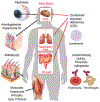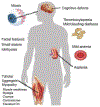CRAC channels and disease - From human CRAC channelopathies and animal models to novel drugs
- PMID: 31009822
- PMCID: PMC6545165
- DOI: 10.1016/j.ceca.2019.03.004
CRAC channels and disease - From human CRAC channelopathies and animal models to novel drugs
Abstract
Ca2+ release-activated Ca2+ (CRAC) channels are intimately linked with health and disease. The gene encoding the CRAC channel, ORAI1, was discovered in part by genetic analysis of patients with abolished CRAC channel function. And patients with autosomal recessive loss-of-function (LOF) mutations in ORAI1 and its activator stromal interaction molecule 1 (STIM1) that abolish CRAC channel function and store-operated Ca2+ entry (SOCE) define essential functions of CRAC channels in health and disease. Conversely, gain-of-function (GOF) mutations in ORAI1 and STIM1 are associated with tubular aggregate myopathy (TAM) and Stormorken syndrome due to constitutive CRAC channel activation. In addition, genetically engineered animal models of ORAI and STIM function have provided important insights into the physiological and pathophysiological roles of CRAC channels in cell types and organs beyond those affected in human patients. The picture emerging from this body of work shows CRAC channels as important regulators of cell function in many tissues, and as potential drug targets for the treatment of autoimmune and inflammatory disorders.
Keywords: CRAC channel; Calcium; Disease; Immunodeficiency; Mutation; ORAI1; STIM1.
Copyright © 2019 Elsevier Ltd. All rights reserved.
Conflict of interest statement
Figures




Similar articles
-
ORAI1 Mutations with Distinct Channel Gating Defects in Tubular Aggregate Myopathy.Hum Mutat. 2017 Apr;38(4):426-438. doi: 10.1002/humu.23172. Epub 2017 Feb 2. Hum Mutat. 2017. PMID: 28058752
-
Gain-of-function mutations in STIM1 and ORAI1 causing tubular aggregate myopathy and Stormorken syndrome.Cell Calcium. 2018 Dec;76:1-9. doi: 10.1016/j.ceca.2018.07.008. Epub 2018 Sep 3. Cell Calcium. 2018. PMID: 30243034 Review.
-
Functional analyses of STIM1 mutations reveal a common pathomechanism for tubular aggregate myopathy and Stormorken syndrome.Neuropathology. 2020 Dec;40(6):559-569. doi: 10.1111/neup.12692. Epub 2020 Oct 19. Neuropathology. 2020. PMID: 33073872
-
Activating mutations in STIM1 and ORAI1 cause overlapping syndromes of tubular myopathy and congenital miosis.Proc Natl Acad Sci U S A. 2014 Mar 18;111(11):4197-202. doi: 10.1073/pnas.1312520111. Epub 2014 Mar 3. Proc Natl Acad Sci U S A. 2014. PMID: 24591628 Free PMC article.
-
Tubular aggregate myopathy and Stormorken syndrome: Mutation spectrum and genotype/phenotype correlation.Hum Mutat. 2020 Jan;41(1):17-37. doi: 10.1002/humu.23899. Epub 2019 Sep 15. Hum Mutat. 2020. PMID: 31448844 Review.
Cited by
-
Prostaglandin E2 receptor EP4 regulates cell migration through Orai1.Cancer Sci. 2020 Jan;111(1):160-174. doi: 10.1111/cas.14247. Epub 2019 Dec 18. Cancer Sci. 2020. PMID: 31755615 Free PMC article.
-
Differential Expression of Genes Regulating Store-operated Calcium Entry in Conjunction With Mitochondrial Dynamics as Potential Biomarkers for Cancer: A Single-Cell RNA Analysis.Front Genet. 2022 May 31;13:866473. doi: 10.3389/fgene.2022.866473. eCollection 2022. Front Genet. 2022. PMID: 35711942 Free PMC article.
-
S-acylation of Orai1 regulates store-operated Ca2+ entry.J Cell Sci. 2022 Mar 1;135(5):jcs258579. doi: 10.1242/jcs.258579. Epub 2021 Jun 22. J Cell Sci. 2022. PMID: 34156466 Free PMC article.
-
STIM1 and lipid interactions at ER-PM contact sites.Am J Physiol Cell Physiol. 2025 Jan 1;328(1):C107-C114. doi: 10.1152/ajpcell.00634.2024. Epub 2024 Dec 2. Am J Physiol Cell Physiol. 2025. PMID: 39620863 Free PMC article. Review.
-
Complexity and Specificity of Sec61-Channelopathies: Human Diseases Affecting Gating of the Sec61 Complex.Cells. 2021 Apr 27;10(5):1036. doi: 10.3390/cells10051036. Cells. 2021. PMID: 33925740 Free PMC article. Review.
References
-
- Putney JW Jr., A model for receptor-regulated calcium entry, Cell Calcium, 7 (1986) 1–12. - PubMed
-
- Soboloff J, Romanin C, STIM1 Structure-function and Downstream Signaling Pathways, Cell Calcium, (2019). - PubMed
-
- Feske S, Giltnane J, Dolmetsch R, Staudt LM, Rao A, Gene regulation mediated by calcium signals in T lymphocytes, Nat Immunol, 2 (2001) 316–324. - PubMed
-
- Feske S, Muller JM, Graf D, Kroczek RA, Drager R, Niemeyer C, Baeuerle PA, Peter HH, Schlesier M, Severe combined immunodeficiency due to defective binding of the nuclear factor of activated T cells in T lymphocytes of two male siblings, Eur J Immunol, 26 (1996) 2119–2126. - PubMed
-
- Le Deist F, Hivroz C, Partiseti M, Thomas C, Buc HA, Oleastro M, Belohradsky B, Choquet D, Fischer A, A primary T-cell immunodeficiency associated with defective transmembrane calcium influx, Blood, 85 (1995) 1053–1062. - PubMed
Publication types
MeSH terms
Substances
Supplementary concepts
Grants and funding
LinkOut - more resources
Full Text Sources
Medical
Miscellaneous

